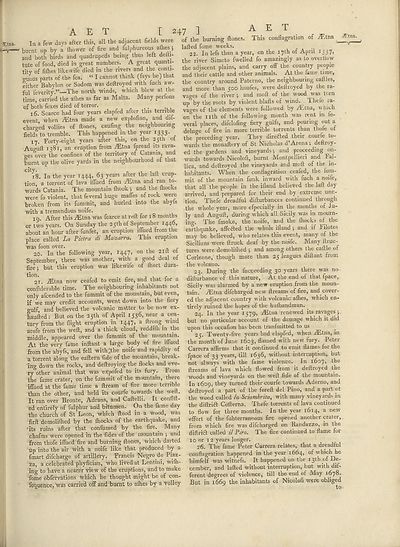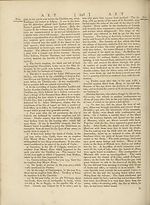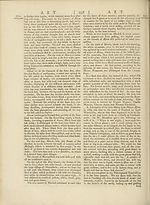Encyclopaedia Britannica, or, a Dictionary of arts, sciences, and miscellaneous literature : enlarged and improved. Illustrated with nearly six hundred engravings > Volume 1, A-AME
(273) Page 247
Download files
Complete book:
Individual page:
Thumbnail gallery: Grid view | List view

A E T [ 247 ]
In a few days after this, all the adjacent fields were of the burning ftones.
burnt up by a thower of fire and fulphureous aflres j
and both birds and quadrupeds being thus left defix-
tute of food, died in great numbers. A great quanti¬
fy of fifties likewife died in the rivers and the conti¬
guous parts of the fea. “ I cannot think (fays he) that
either Babylon or Sodom was deftroyed with fuch aw¬
ful feverity.”—The north winds, which blew at the
time, carried the allies as far as Malta. Many perfons
of both fexes died of terror. ^
16. Scarce had four years elapfed after this terrible
event, when ^Etna made a new explofion, and dif-
charged vollies of ftones, caufing the neighbouring
fields to tremble. This happened in the year 1333.
17. Forty-eight years after this, on the 25th 01
Auguft 1381, an eruption from ./Etna fpread its rava¬
ges over the confines of the territory of Catania, and
burnt up the olive yards in the neighbourhood of that
18. In the year 1444, 63 years after the laft erup¬
tion, a torrent of lava iffued from ./Etna and ran to¬
wards Catania. The mountain ftiook ; and the ftiocks
were fo violent, that feveral huge malTes of rock were
broken from its fummit, and hurled into the abyls
with a tremendous noife.
19. After this ./Etna was fcarce at reft for 18 months
or two years. On Sunday the 25th of September 1446,
about an hour after funfet, an eruption iffued from the
place called La Pietra di Mazarra. This eruption
was foon over. .
20. In the following year, 1447, on the 2lit ot
September, there was another, with a good deal of
fire; but this eruption was likewife of ftiort dura-
txon. . 1 , r
2T. ./Etna now ceafed to emit fire, and that tor a
confiderable time. The neighbouring inhabitants not
only afcended to the fummit of the mountain, but even,
if we may credit accounts, went down into the fiery
gulf, and believed the volcanic matter to be now ex-
haufted: But on the 25th of April 1536, near a cen¬
tury from the flight eruption in 1447, a ftrong_ wind
arofe from the weft, and a thick cloud, reddifti in the
middle, appeared over the fummit of the mountain.
At the very fame inftant a large body of fire ilfued
from the abyfs, and fell with‘.the noife and rapidity of
a torrent along the eaftern fide of the mountain, break¬
ing down the rocks, and deftroying the flocks and eve¬
ry other animal that was expofed to its fury. From
the fame crater, on the fummit of the mountain, there
iffued at the fame time a ftream of fire more terrible
than the other, and held its courfe towards the weft.
It ran over Bronte, Adrans, and Caftelli. It confid¬
ed entirely of fulphur and bitumen. On the fame day
the church of St Leon, which flood in a wood, was
firft demoliftied by the (hocks of the earthquake, and
'its ruins after that con fumed by the fire.. Many
chafms were opened in the (ides of the mountain j and
from thofe iffued fire and burning ftones, which darted
up into the air With a noi(e like that produced by a
fmart difcharge of artillery. Francis Ncgro.de Piaz¬
za, a celebrated phyfician, who lived at Lentini, wifh-
ing to have a nearer view of the eruptions, and to make
fome obfervations which he thought might be of con-
fequence, was carried off and burnt to afties by a volley
A E T
This conflagration of yEtna
lafted fome weeks.
22. In lefs than a year, on the 17th ot April 1537,
the river Simeto fwelled fo amazingly as to overflow
the adjacent plains, and carry off the country people
and their cattle and ether animals. At the fame time,
the country around Paterno, the neighbouring caftles,
and more than 500 houfes, were deftroyed by the ra¬
vages of the river j and moft of the wood was torn
up by the roots by violent blafts of wind. Theie ra-
vao-es of the elements were followed by ./Etna, which
on&the nth of the following month was rent in fe¬
veral places, difclofing fiery gulfs, and pouring out a
deluge of fire in more terrible torrents than thofe of
the preceding year. 1 hey direfled their courle to¬
wards the monaftery of St Nicholas d’Arena; deftroy¬
ed the gardens and vineyards j and proceeding on¬
wards towards Nicolofi, burnt Montpellieri and Fal-
lica, and deftroyed the vineyards and moil of the in¬
habitants. When the conflagration ceafed, the ium-
mit of the mountain funk inward with fuch a noile,
that all the people in the iftand believed the laft day
arrived, and prepared for their end by extreme unc-
■' Thefe dreadful difturbances continued through
iFtna.
the whole year, more efpecially in the months of Ju¬
ly and Auguft, during which all Sicily was in mourn¬
ing. The fmoke, the noife, and the (hocks ot the
earthquake, affedled the whole ifland j and if Filotes
may be believed, who relates this event, many of the
Sicilians vrere (truck deaf by the noife. Many fttuc-
tures were demoliftied 5 and among others the cattle of
Corleone, though more than 25 leagues diftant from
the volcano.
23. During the fucceeding 30 years there was no
difturbance of this nature, At the end of that fpace,
Sicily was alarmed by a new eruption from the moun¬
tain. ./Etna difcharged new dreams of fire, and cover¬
ed the adjacent country with volcanic afties, which en¬
tirely ruined the hopes of the hufbandman.
24. In the year 1579, ./Etna renewed its.ravages j
but no particular account of the damage which it did
upon this occafion has been tranfmitted to us
1 25. Twenty-five years had tlapfed, when ./Etna, in
the month of June 1603, flamed w'ith new fury. Petei
Carrera affirms that it continued to emit flames for the
fpace of 33 years, till 1636, without interruption, but
not always with the fame violence. In 1607, the
dreams of lava which flowed from it deftroyed the
woods and vineyards on the weft fide of the mountain.
In 1609, they turned their courfe towards Aderno, and
deftroyed a part of the foreft del Pino, and a part ot
the wood called la Sciambrita, with many vineyards in
the diftrift Cofterna. Thefe torrents of lava continued
to flow for three months. In the year 1614, a new
effort of the fubterraneous fire opened another crater,
from which fire was difcharged on Randazzo, in the
diftridl called il Piro. The fire continued to flame for
10 or 12 years longer.
26. The fame Peter Carrera relates, that a dreadful
conflagration happened in the year 1664, of which he
himfelf was witnefs. It happened on the 13th of De¬
cember, and lafted without interruption, but with dif¬
ferent degrees of violence, till the end ot May 1678.
But in 1669 the inhabitants of Nicolofi were obliged
In a few days after this, all the adjacent fields were of the burning ftones.
burnt up by a thower of fire and fulphureous aflres j
and both birds and quadrupeds being thus left defix-
tute of food, died in great numbers. A great quanti¬
fy of fifties likewife died in the rivers and the conti¬
guous parts of the fea. “ I cannot think (fays he) that
either Babylon or Sodom was deftroyed with fuch aw¬
ful feverity.”—The north winds, which blew at the
time, carried the allies as far as Malta. Many perfons
of both fexes died of terror. ^
16. Scarce had four years elapfed after this terrible
event, when ^Etna made a new explofion, and dif-
charged vollies of ftones, caufing the neighbouring
fields to tremble. This happened in the year 1333.
17. Forty-eight years after this, on the 25th 01
Auguft 1381, an eruption from ./Etna fpread its rava¬
ges over the confines of the territory of Catania, and
burnt up the olive yards in the neighbourhood of that
18. In the year 1444, 63 years after the laft erup¬
tion, a torrent of lava iffued from ./Etna and ran to¬
wards Catania. The mountain ftiook ; and the ftiocks
were fo violent, that feveral huge malTes of rock were
broken from its fummit, and hurled into the abyls
with a tremendous noife.
19. After this ./Etna was fcarce at reft for 18 months
or two years. On Sunday the 25th of September 1446,
about an hour after funfet, an eruption iffued from the
place called La Pietra di Mazarra. This eruption
was foon over. .
20. In the following year, 1447, on the 2lit ot
September, there was another, with a good deal of
fire; but this eruption was likewife of ftiort dura-
txon. . 1 , r
2T. ./Etna now ceafed to emit fire, and that tor a
confiderable time. The neighbouring inhabitants not
only afcended to the fummit of the mountain, but even,
if we may credit accounts, went down into the fiery
gulf, and believed the volcanic matter to be now ex-
haufted: But on the 25th of April 1536, near a cen¬
tury from the flight eruption in 1447, a ftrong_ wind
arofe from the weft, and a thick cloud, reddifti in the
middle, appeared over the fummit of the mountain.
At the very fame inftant a large body of fire ilfued
from the abyfs, and fell with‘.the noife and rapidity of
a torrent along the eaftern fide of the mountain, break¬
ing down the rocks, and deftroying the flocks and eve¬
ry other animal that was expofed to its fury. From
the fame crater, on the fummit of the mountain, there
iffued at the fame time a ftream of fire more terrible
than the other, and held its courfe towards the weft.
It ran over Bronte, Adrans, and Caftelli. It confid¬
ed entirely of fulphur and bitumen. On the fame day
the church of St Leon, which flood in a wood, was
firft demoliftied by the (hocks of the earthquake, and
'its ruins after that con fumed by the fire.. Many
chafms were opened in the (ides of the mountain j and
from thofe iffued fire and burning ftones, which darted
up into the air With a noi(e like that produced by a
fmart difcharge of artillery. Francis Ncgro.de Piaz¬
za, a celebrated phyfician, who lived at Lentini, wifh-
ing to have a nearer view of the eruptions, and to make
fome obfervations which he thought might be of con-
fequence, was carried off and burnt to afties by a volley
A E T
This conflagration of yEtna
lafted fome weeks.
22. In lefs than a year, on the 17th ot April 1537,
the river Simeto fwelled fo amazingly as to overflow
the adjacent plains, and carry off the country people
and their cattle and ether animals. At the fame time,
the country around Paterno, the neighbouring caftles,
and more than 500 houfes, were deftroyed by the ra¬
vages of the river j and moft of the wood was torn
up by the roots by violent blafts of wind. Theie ra-
vao-es of the elements were followed by ./Etna, which
on&the nth of the following month was rent in fe¬
veral places, difclofing fiery gulfs, and pouring out a
deluge of fire in more terrible torrents than thofe of
the preceding year. 1 hey direfled their courle to¬
wards the monaftery of St Nicholas d’Arena; deftroy¬
ed the gardens and vineyards j and proceeding on¬
wards towards Nicolofi, burnt Montpellieri and Fal-
lica, and deftroyed the vineyards and moil of the in¬
habitants. When the conflagration ceafed, the ium-
mit of the mountain funk inward with fuch a noile,
that all the people in the iftand believed the laft day
arrived, and prepared for their end by extreme unc-
■' Thefe dreadful difturbances continued through
iFtna.
the whole year, more efpecially in the months of Ju¬
ly and Auguft, during which all Sicily was in mourn¬
ing. The fmoke, the noife, and the (hocks ot the
earthquake, affedled the whole ifland j and if Filotes
may be believed, who relates this event, many of the
Sicilians vrere (truck deaf by the noife. Many fttuc-
tures were demoliftied 5 and among others the cattle of
Corleone, though more than 25 leagues diftant from
the volcano.
23. During the fucceeding 30 years there was no
difturbance of this nature, At the end of that fpace,
Sicily was alarmed by a new eruption from the moun¬
tain. ./Etna difcharged new dreams of fire, and cover¬
ed the adjacent country with volcanic afties, which en¬
tirely ruined the hopes of the hufbandman.
24. In the year 1579, ./Etna renewed its.ravages j
but no particular account of the damage which it did
upon this occafion has been tranfmitted to us
1 25. Twenty-five years had tlapfed, when ./Etna, in
the month of June 1603, flamed w'ith new fury. Petei
Carrera affirms that it continued to emit flames for the
fpace of 33 years, till 1636, without interruption, but
not always with the fame violence. In 1607, the
dreams of lava which flowed from it deftroyed the
woods and vineyards on the weft fide of the mountain.
In 1609, they turned their courfe towards Aderno, and
deftroyed a part of the foreft del Pino, and a part ot
the wood called la Sciambrita, with many vineyards in
the diftrift Cofterna. Thefe torrents of lava continued
to flow for three months. In the year 1614, a new
effort of the fubterraneous fire opened another crater,
from which fire was difcharged on Randazzo, in the
diftridl called il Piro. The fire continued to flame for
10 or 12 years longer.
26. The fame Peter Carrera relates, that a dreadful
conflagration happened in the year 1664, of which he
himfelf was witnefs. It happened on the 13th of De¬
cember, and lafted without interruption, but with dif¬
ferent degrees of violence, till the end ot May 1678.
But in 1669 the inhabitants of Nicolofi were obliged
Set display mode to:
![]() Universal Viewer |
Universal Viewer | ![]() Mirador |
Large image | Transcription
Mirador |
Large image | Transcription
Images and transcriptions on this page, including medium image downloads, may be used under the Creative Commons Attribution 4.0 International Licence unless otherwise stated. ![]()
| Permanent URL | https://digital.nls.uk/193135534 |
|---|
| Attribution and copyright: |
|
|---|
| Description | Ten editions of 'Encyclopaedia Britannica', issued from 1768-1903, in 231 volumes. Originally issued in 100 weekly parts (3 volumes) between 1768 and 1771 by publishers: Colin Macfarquhar and Andrew Bell (Edinburgh); editor: William Smellie: engraver: Andrew Bell. Expanded editions in the 19th century featured more volumes and contributions from leading experts in their fields. Managed and published in Edinburgh up to the 9th edition (25 volumes, from 1875-1889); the 10th edition (1902-1903) re-issued the 9th edition, with 11 supplementary volumes. |
|---|---|
| Additional NLS resources: |
|

